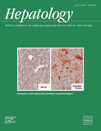Viral load in hepatitis B e antigen–negative carriers with normal aminotransferase level†
Potential conflict of interest: Nothing to report.
In the May issue of HEPATOLOGY, Lin et al.1 addressed an important clinical issue of hepatitis B e antigen (HBeAg)-negative hepatitis B surface antigen (HBsAg) carriers with persistently normal serum alanine aminotransferase (ALT) levels (PNALT) using a highly sensitive quantitative assay for hepatitis B virus (HBV) DNA. They found that serum HBV-DNA level >104 copies/mL was independently associated with high-normal ALT (0.5-1 times upper limit of normal). However, some of their findings are unexpected and deserve further discussion.
Of their 414 HBeAg-negative carriers with PNALT, so-called inactive HBsAg carriers according to conventional loose criteria,2 32% had a HBV-DNA level >105 copies/mL and 56% had a level >104 copies/mL. Compared with the results of a few earlier studies,3-6 these figures are obviously much higher (Fig. 1). Of these studies, only Lin's HBeAg-negative subjects had HBV-DNA levels >105 copies/mL despite that the duration of PNALT was at least 2 years before entry to the study.1 It appears that age, sex, ethnicity, and duration of PNALT are not likely the reason(s) for this discrepancy (Fig. 1). Perhaps the authors have a good explanation.

Currently, a stringent viral criterion for “inactive HBsAg carrier” is set at <1 × 104 copies/mL or 2 × 103 IU/mL, and serial testing in such HBsAg carriers is required to verify that they are truly “inactive”.2, 7 By these criteria, 56% of Lin's patients were not “inactive”. In the subgroup analysis, however, only 12 of their 76 subjects with detectable HBV-DNA at study entry went from low-normal to high-normal ALT levels after a follow-up period of 12-77 months, but none of them encountered ALT elevation to abnormal level.1 This finding is also contradictory to earlier observations: abnormal ALT level was observed between the third and twelfth month of follow-up in all 25 HBeAg-negative subjects with normal baseline ALT but higher HBV-DNA level5; the only 4 subjects with serum HBV-DNA >104 copies/mL at presentation in another study all exhibited ALT elevation during follow-up.6 We recently followed 1241 asymptomatic HBeAg-negative HBsAg carriers with PNALT for 14,484 person-years and found that the cumulative probability of hepatitis relapse was 5% at the 2-year follow-up and 10% at the 5-year follow-up.8 Given these findings in earlier studies and the finding that 16% of Lin's patients had an HBV-DNA level >106 and 32% had a level >105 copies/mL, it is anticipated that the dynamic interaction between the host and HBV in these patients would result in elevated ALT level during follow-up. The finding that only mild elevation of ALT to high-normal level in their patients seems contradictory to the general concept.
Although there was no histologic evidence to support the speculation by Lin et al. that high-normal ALT was associated with liver disease progression, they have provided evidence to show that HBeAg-negative subjects with PNALT are not a homogeneous group.1 It will be interesting to see whether this still holds true if patients with a serum HBV-DNA level >104 or 105 copies/mL were excluded from the analyses.
References
Yun-Fan Liaw M.D.*, * Liver Research Unit, Chang Gung Memorial Hospital & Chang Gung University, Taipei, Taiwan.




